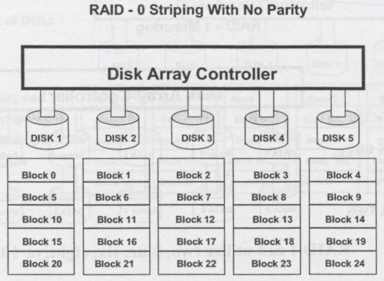In computer data storage, data striping is the technique of segmenting logically sequential data, such as a file, so that consecutive segments are stored on different physical storage devices.
Striping is useful when a processing device requests data more quickly than a single storage device can provide it. By spreading segments across multiple devices which can be accessed concurrently, total data throughput is increased. It is also a useful method for balancing I/O load across an array of disks. Striping is used across disk drives in redundant array of independent disks (RAID) storage, network interface controllers, different computers in clustered file systems and grid-oriented storage, and RAM in some systems.
Method
One method of striping is done by interleaving sequential segments on storage devices in a round-robin fashion from the beginning of the data sequence. This works well for streaming data, but subsequent random accesses will require knowledge of which device contains the data. If the data is stored such that the physical address of each data segment is assigned a 1-to-1 mapping to a particular device, the device to access each segment requested can be calculated from the address without knowing the offset of the data within the full sequence.
Other methods might be employed in which sequential segments are not stored on sequential devices. Such non-sequential interleaving can have benefits in some error correction schemes.
Advantages and disadvantages
Advantages of striping include performance and throughput. Sequential time interleaving of data accesses allows the lesser data access throughput of each storage devices to be cumulatively multiplied by the number of storage devices employed. Increased throughput allows the data processing device to continue its work without interruption, and thereby finish its procedures more quickly. This is manifested in improved performance of the data processing.
Because different segments of data are kept on different storage devices, the failure of one device causes the corruption of the full data sequence. In effect, the failure rate of the array of storage devices is equal to the sum of the failure rate of each storage device. This disadvantage of striping can be overcome by the storage of redundant information, such as parity, for the purpose of error correction. In such a system, the disadvantage is overcome at the cost of requiring extra storage.
Terminology
The segments of sequential data written to or read from a disk before the operation continues on the next disk are usually called chunks, strides or stripe units, while their logical groups forming single striped operations are called strips or stripes. The amount of data in one chunk (stripe unit), often denominated in bytes, is variously referred to as the chunk size, stride size, stripe size, stripe depth or stripe length. The number of data disks in the array is sometimes called the stripe width, but it may also refer to the amount of data within a stripe. The amount of data in one strip multiplied by the number of data disks in the array (i.e., stripe depth times stripe width, which in the geometrical analogy would yield an area) is sometimes called the stripe size or stripe width. Wide striping occurs when chunks of data are spread across multiple arrays, possibly all the drives in the system. Narrow striping occurs when the chunks of data are spread across the drives in a single array.
Applications
Data striping is used in some databases, such as Sybase, and in certain RAID devices under software or hardware control, such as IBM's 9394 RAMAC Array subsystem. File systems of clusters also use striping. Oracle Automatic Storage Management allows ASM files to be either coarse or fine striped.
Linux LVM
Data striping can also be achieved with Linux's Logical Volume Management (LVM). The LVM system allows for the adjustment of coarseness of the striping pattern. LVM tools will allow implementation of data striping in conjunction with mirroring; however, LVM1 will not allow adding additional disks to a striped Logical Volume (LV). This can be achieved with LVM2 using LVM2 format metadata.
RAID
In some RAID configurations (such as RAID-0) if one RAID disk fails, this file (and all other data), will be lost. In other RAID configurations (such as a RAID-5 with a parity drive), if one drive fails the data can be restored by using the other drives in the array. This is because RAID-5 uses parity error correcting redundancy.

